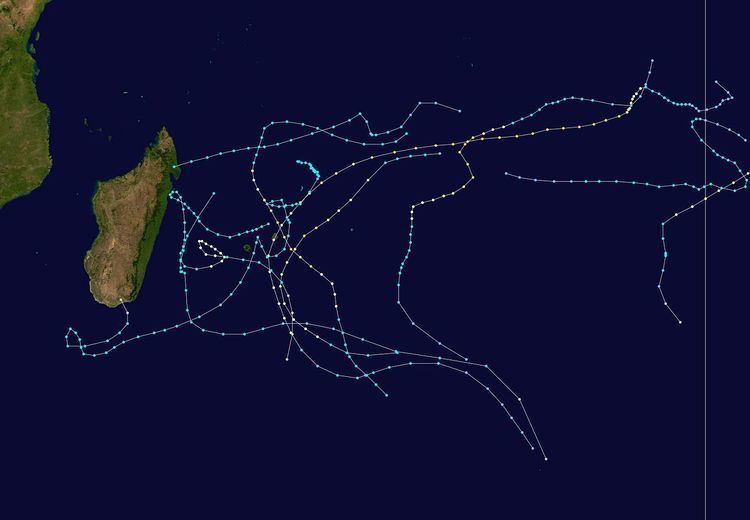First system formed August 30, 1979 Name Viola-Claudette Total damage Unknown | Last system dissipated March 20, 1980 Total fatalities Unknown | |
 | ||
The 1979–80 South-West Indian Ocean cyclone season was a below average cyclone season. The season officially ran from November 1, 1979, to April 30, 1980.
Contents
Tropical Cyclone Tony
On 26 August, TCWC Perth reported that a tropical low had developed on a shear line about 1300 km (810 mi) to the northwest of Cocos Island. Over the next couple of days the depression gradually developed further before at 1800 UTC on 27 August, TCWC Perth estimated that it had become a tropical cyclone and named it Tony. During the next couple of days, the system moved towards the west-southwest before on 29 August it reached its peak intensity of 95 km/h (60 mph) and a peak pressure of 990 hPa (29.23 inHg) as it approached the edge of TCWC Perth's area of responsibility. During the next day, Tony moved into the South West Indian Ocean and weakened gradually before it dissipated during 31 August. Neither the Mauritius or Reunion meteorological services monitored Tony as a tropical cyclone while it was active, while it was not included in the JTWC's analysis of the season.
Intense Tropical Cyclone Albine
Albine existed from 25 November to 6 December.
Intense Tropical Cyclone Viola-Claudette
Viola-Claudette existed from 10 December to 28 December.
Severe Tropical Storm Berenice
Berenice existed from 15 December to 21 December.
Severe Tropical Cyclone Wilf-Danitza
Wilf-Danitza existed from 23 December, 1979, to 3 January, 1980.
Tropical Cyclone Hyacinthe
Hyacinthe formed on January 15, 1980, to the northeast of Mauritius in the southern Indian Ocean. Initially it moved to the west-southwest, and while slowly intensifying it passed north of the French overseas department of Réunion. On January 19, Météo-France estimated that the storm had intensified to a tropical cyclone. Hyacinthe looped to the south of eastern Madagascar and weakened, although it restrengthened after turning to the east. The storm executed another loop to the southwest of Réunion, passing near the island for a second and later third time. Hyacinthe became extratropical on January 29 after turning southward, dissipating two days later.
Tropical Cyclone Hyacinthe set several worldwide tropical cyclone rainfall records in Réunion in the Southwestern Indian Ocean, including a peak total of 5678 mm (223.5 inches). For twelve days, Hyacinthe dropped torrential rainfall on Réunion; nearly all of the island received more than 1 m (3.3 ft) of precipitation. Over a 15‑day period from January 14 to January 28, 6,083 mm (239.5 in) of rainfall were recorded at Commerson's Crater, a volcano. The heaviest rainfall occurred through a process called orographic lift in the mountainous interior, leading to hundreds of landslides. Widespread floods washed out roads and isolated three villages. Hyacinthe caused heavy damage to crops and damaged or destroyed 2,000 houses. Losses from the storm totaled $167 million (1980 USD, 676 million francs), and 25 people were killed.
Cyclone Jacinthe
Jacinthe existed from 1 February to 7 February.
Cyclone Fred
Fred existed from 20 February to 28 February.
Cyclone Kolia
Kolia existed from 25 February to 13 March.
Cyclone Laure
Laure existed from 8 March to 17 March.
Cyclone 22S
22S existed from 14 March to 20 March.
